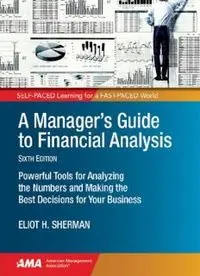
A Manager's Guide to Financial Analysis: Powerful Tools for Analyzing the Numbers and Making the Best Decisions for Your Business PDF
Preview A Manager's Guide to Financial Analysis: Powerful Tools for Analyzing the Numbers and Making the Best Decisions for Your Business
A Manager’s Guide to Financial Analysis Sixth Edition Powerful Tools for Analyzing the Numbers and Making the Best Decisions for Your Business This page intentionally left blank A Manager’s Guide to Financial Analysis Sixth Edition Powerful Tools for Analyzing the Numbers and Making the Best Decisions for Your Business Eliot H. Sherman A Manager’s Guide to Financial Analysis, Sixth Edition Powerful Tools for Analyzing the Numbers and Making the Best Decisions for Your Business © 2015 American Management Association. All rights reserved. This material may not be reproduced, stored in a retrieval system, or transmitted in whole or in part, in any form or by any means, electronic, mechanical, photocopying, recording, or otherwise, without the prior written permission of the publisher. ISBN 13: 978-0-7612-1561-5 ISBN 10: 0-7612-1561-1 AMACOM Self-Study Program http://www.amaselfstudy.org AMERICAN MANAGEMENT ASSOCIATION http://www.amanet.org Contents About This Course xi How to Take This Course xiii Pre-Test xv Introduction xxi 1 Financial Decision Making and the 1 Techniques Used in Financial Analysis Financial Analysis The Role of the Financial Analyst Definition of the Analyst’s Job Typical Assignments The Analyst’s Position in the Corporate Structure Financial Management and Financial Analysis Activities and Financial Statements Business Strategy Competitive Environment The Application of Analytical Techniques for Specific Problems Investment Decisions Financing Decisions Dividend Policy Primary Goal of Financial Analysis Long-Range versus Short-Range Goals The Balanced Scorecard Techniques Presented in This Course Recap Review Questions 2 Financial Statement Analysis 17 Differing Viewpoints The Basic Structure of Financial Statements The Balance Sheet The Income Statement The Statement of Stockholders’ Equity The Statement of Cash Flows © American Management Association. All rights reserved. http://www.amanet.org/ v vi A MANAGER’S GUIDE TO FINANCIAL ANALYSIS Financial Statement Analysis Limitations of Financial Statement Analysis Horizontal Analysis Vertical Analysis Recap Review Questions 3 Ratio Analysis for Financial Statements 39 Ratio Analysis Profitability Ratios Net Profit Margin Operating Profit Margin Return on Assets(ROA) Return on Equity (ROE) Analyzing Return on Equity (ROE) Using the DuPont Analysis Earnings per Share (EPS) Price Earnings Ratio (P/E) Dividend Yield and Payout Economic Value Added (EVA) Liquidity Ratios Current Ratio Quick Ratio Net Liquid Balance Activity Ratios Average Collection Period Inventory Turnover Total Asset Turnover Operating Cycle Working Capital Requirements Free Cash Flow Debt and Equity Ratios Leverage Debt-to-Equity Ratio Times-Interest-Earned Ratio (TIE) Book Value per Share of Common Stock Using Financial Ratios Intracompany Analysis Trend Analysis Industry Comparison Predicting Financial Problems Using Financial Ratios in Analysis An Example of Intracompany Analysis An Example of Industry Comparison Other Commonly Used Analytical Ratios Important Considerations Concerning Financial Statement Information Alternative Asset Management Treatments Cash and Marketable Securities Accounts Receivable Inventory © American Management Association. All rights reserved. http://www.amanet.org/ CONTENTS vii Fixed Assets Goodwill and Intangible Assets Alternative Liability and Equity Treatments Current Liabilities Leasing Assets Rather Than Buying Them Pensions and Other Post-Retirement Benefits Stockholders’ Equity Recap Review Questions 4 Analyzing Current Asset Management 85 Cash Management Motives for Holding Cash Collection and Disbursement Techniques Other Aspects of Cash Management Accounts Receivable: Credit and Collection Policies Credit Quality Standards Credit Terms Collection Efforts Inventory Management Considerations Raw Material Work in Process Finished Goods Recap Review Questions 5 Evaluating Capital Investment Proposals 105 The Capital Budgeting Process Determining the Cost of Capital or Discount Rate The Cash Flow from an Investment Risk and Capital Investments Types of Risk The Cost of Capital Risk Measurement and Cash Flow Uncertainty Alternative Ways to Measure Risk and Cash Flow Uncertainty The Level of Risk and the Project’s Discount Rate Evaluating Capital Investments Evaluation Methods Excluding the Time Value of Money Evaluation Methods Recognizing the Time Value of Money The Post-Audit Recap Review Questions 6 Forecasting and Valuation 143 Forecasting the Future The Financial Forecast Calculating the Forecast © American Management Association. All rights reserved. http://www.amanet.org/ viii A MANAGER’S GUIDE TO FINANCIAL ANALYSIS Constructing a Valuation Model Defining the Valuation Theory Recap Review Questions 7 Capital Structure and Dividend Policy 155 Issues in Capital Structure and Dividend Policy Business and Financial Risk Business Risk Financial Risk Optimal Capital Structure Dividend Policy Preferences of Stockholders Factors Affecting Dividend Policy Stock Dividends and Stock Splits Stock Repurchases Recap Review Questions 8 Mergers and Acquisitions 171 Motives for Mergers Search and Screening Screening Criteria Qualitative Criteria Risk Assessment Price Assessment Management Defenses Measuring the Financial Impact of an Acquisition The Exchange Ratio Purchase with Cash Purchase with Acquiring Company’s Stock An Analysis of the Bargaining Position of Both Companies The Impact on Earnings per Share The Level of Earnings per Share The Growth in Earnings per Share The Impact on the Price-Earnings Ratio Valid and Invalid Motives for Merging Expected Return from an Acquisition or Merger Establishing a Valuation from the Acquiree’s Perspective Recap Review Questions © American Management Association. All rights reserved. http://www.amanet.org/ CONTENTS ix Answers to Quick Quiz Questions 191 Bibliography 197 Additional Resources 199 Glossary 201 Post-Test 213 Index 219 FOR QUESTIONS AND COMMENTS: Please contact Self Study at 1-800-225-3215 or email
